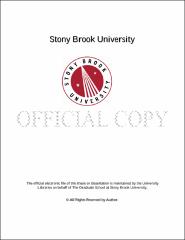| dc.identifier.uri | http://hdl.handle.net/11401/76780 | |
| dc.description.sponsorship | This work is sponsored by the Stony Brook University Graduate School in compliance with the requirements for completion of degree. | en_US |
| dc.format | Monograph | |
| dc.format.medium | Electronic Resource | en_US |
| dc.language.iso | en_US | |
| dc.publisher | The Graduate School, Stony Brook University: Stony Brook, NY. | |
| dc.type | Dissertation | |
| dcterms.abstract | Veterans returning from the recent Middle East wars report struggling with a variety of transition issues related to wartime experiences and due to the socialization they received as part of their indoctrination into military life. Many veterans experience practical and emotional adjustment challenges related to experiences common to military personnel regardless of combat exposure that may not appear for months or years after separating from the military. Much of the existing research has focused on quantitative measures of veterans’ transition. There is a need for a greater qualitative research focus on understanding the subjective experience of coming home and what strategies veterans are using to support their return to civilian life. This study explored how veterans’ experience the return to civilian life with the goal of identifying components of an optimal transition. Using qualitative methodology, forty veterans were interviewed using a semi-structured interview guide. A phenomenological orientation guided the study emphasizing the lived experience of the participants. Thematic analysis of the study data was used to identify patterns and emergent themes. Social identity theory and attachment theory were used as the framework for understanding the persistent power of indoctrination into military identity and attachment to one’s comrades as both a source of significant loss and a potential asset to be utilized in facilitating the transition to post-military life. Using the transition criteria in the Military to Civilian Questionnaire (Sayer, et al 2011), study participants were divided into three groups based on level of functioning at the time of the interview. The findings suggest that veterans who experience the most successful transition have connected to community providing social support and created new meaning and mission for their lives. The best functioning veterans were able to access an array of coping skills allowing them to process emotions and engage in the tasks of creating a meaningful civilian life. The study proposes a model for assessing veterans leading to a continuum of care. The study findings have important implications for collaborative programs and policy and the social work profession. Recommendations for future research are included. | |
| dcterms.abstract | Veterans returning from the recent Middle East wars report struggling with a variety of transition issues related to wartime experiences and due to the socialization they received as part of their indoctrination into military life. Many veterans experience practical and emotional adjustment challenges related to experiences common to military personnel regardless of combat exposure that may not appear for months or years after separating from the military. Much of the existing research has focused on quantitative measures of veterans’ transition. There is a need for a greater qualitative research focus on understanding the subjective experience of coming home and what strategies veterans are using to support their return to civilian life. This study explored how veterans’ experience the return to civilian life with the goal of identifying components of an optimal transition. Using qualitative methodology, forty veterans were interviewed using a semi-structured interview guide. A phenomenological orientation guided the study emphasizing the lived experience of the participants. Thematic analysis of the study data was used to identify patterns and emergent themes. Social identity theory and attachment theory were used as the framework for understanding the persistent power of indoctrination into military identity and attachment to one’s comrades as both a source of significant loss and a potential asset to be utilized in facilitating the transition to post-military life. Using the transition criteria in the Military to Civilian Questionnaire (Sayer, et al 2011), study participants were divided into three groups based on level of functioning at the time of the interview. The findings suggest that veterans who experience the most successful transition have connected to community providing social support and created new meaning and mission for their lives. The best functioning veterans were able to access an array of coping skills allowing them to process emotions and engage in the tasks of creating a meaningful civilian life. The study proposes a model for assessing veterans leading to a continuum of care. The study findings have important implications for collaborative programs and policy and the social work profession. Recommendations for future research are included. | |
| dcterms.available | 2017-09-20T16:51:10Z | |
| dcterms.contributor | Blau, Joel | en_US |
| dcterms.contributor | Peabody, Carolyn | en_US |
| dcterms.contributor | Demers, Denis. | en_US |
| dcterms.contributor | Cohen, Shelly | en_US |
| dcterms.creator | Mitchell, Katherine | |
| dcterms.dateAccepted | 2017-09-20T16:51:10Z | |
| dcterms.dateSubmitted | 2017-09-20T16:51:10Z | |
| dcterms.description | Department of Social Welfare | en_US |
| dcterms.extent | 229 pg. | en_US |
| dcterms.format | Monograph | |
| dcterms.format | Application/PDF | en_US |
| dcterms.identifier | http://hdl.handle.net/11401/76780 | |
| dcterms.issued | 2017-05-01 | |
| dcterms.language | en_US | |
| dcterms.provenance | Made available in DSpace on 2017-09-20T16:51:10Z (GMT). No. of bitstreams: 1
Mitchell_grad.sunysb_0771E_13246.pdf: 1524191 bytes, checksum: 6988023c9450222aeef09719a8d68493 (MD5)
Previous issue date: 1 | en |
| dcterms.publisher | The Graduate School, Stony Brook University: Stony Brook, NY. | |
| dcterms.subject | Social work | |
| dcterms.subject | Peer Support, Qualitative, Reintegration, Veterans | |
| dcterms.title | Becoming Whole Again: A Qualitative Study of Veterans' Return to Civilian Life | |
| dcterms.type | Dissertation | |

